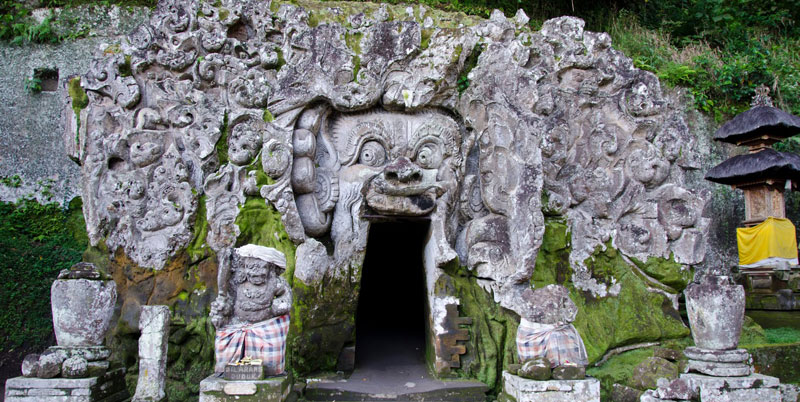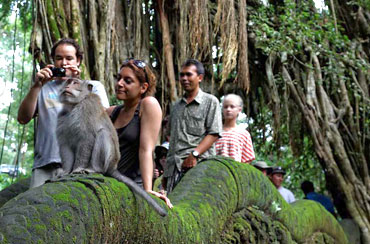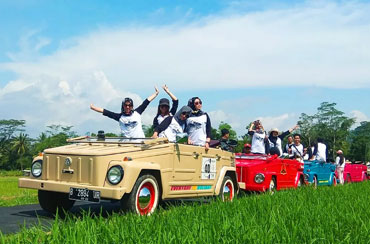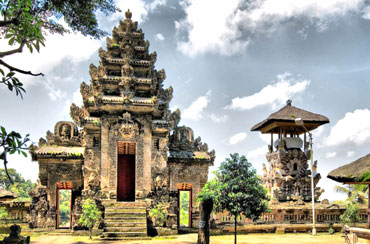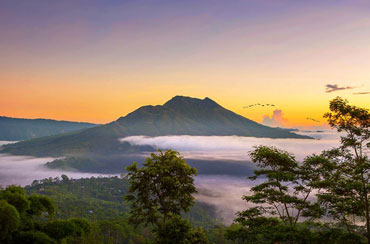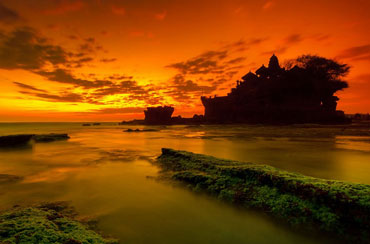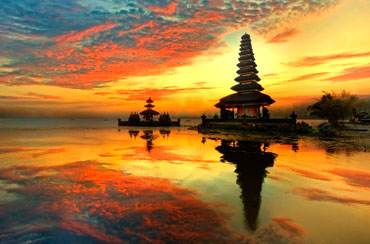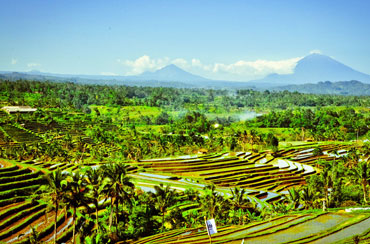GOA GAJAH TEMPLE
GOA GAJAH TEMPLE IS BELIEVED TO DATE BACK TO THE 11TH CENTURY WHEN IT WAS ORIGINALLY BUILT AS A PLACE FOR SPIRITUAL MEDITATION
Goa Gajah Temple name is slightly misleading, lending the impression that it's a gigantic dwelling full of elephants. Nevertheless, Goa Gajah Elephant Cave is an archaeological site of significant historical value that makes it a special place to visit. Located on the cool western edge of Bedulu Village, six kilometers out of central Ubud, you do not need more than an hour to descend to its relic-filled courtyard and view the rock-wall carvings, a central meditational cave, bathing pools and fountains.
All You Need To Know About Goa Gajah Temple :
How to Get to Goa Gajah Temple
Goa Gajah Temple is located near Ubud, Bali, it's only a 10 minute drive east from the Ubud market and town center. The best way to get there is to rent a scooter or hire a private car and driver (both of these can be booked online). If you come from Ubud just by driving south of Ubud past the monkey sanctuary toward Bedulu, then turn east (left) onto Jalan Raya Goa Gajah. Numerous signs indicate the way to Goa Gajah as well as other attractions.
What to Expect at Goa Gajah Temple
Goa Gajah Temple set on the Petanu River at the edge of Bedulu Village, the temple is surrounded by the majestic rainforest with trickling streams and walking paths constructed to take you through the trees. Access to the main grounds is down a flight of stairs from a roadside parking area lined with refreshment kiosks, souvenir shops and art stalls. As you reach the base you will come upon the large wantilan meeting hall and a collection of large ancient stone carvings, some which have been restored to their former glory.
A few yards of the cave that is in the middle of cave courtyard, there is a pond of Patirtaan, a place to take Tirta or holy water for the ceremony. The holy pond was originally buried in the ground and successfully found in 1954 by Krijgsman from the department of antiquities. This holy pond is completed by the statues equipped by showers in form of Widyadara-Widyadari (angels) arranged in a group of three lines with 6 statues (5 statues have been put back). Perhaps at first time there 7 fountain statues, a statue was set in the middle as interrupter but its existence has not been known until now.
The existence of 7 fountain statues are based on the concept of Sapta Tirtha, the seven holy water which has a purity equal to Sapta Nadi (seven purified river includes Gangga, Sindhu, Saraswati, Yamuna, Godawari, Serayu and Narmada. It is a symbolic meaning that taking the water from each fountain has a sacred value like the sacred of Sapta Nadi. Throughout the temple complex, a variety of structures bear Hindu influences which date back to the 10th century as well as relics which feature some elements of Buddhism that date back even earlier, as far back as the 8th century.
The cave itself is actually quite shallow, yet inside you will find three stone idols wrapped individually in yellow, red and black cloth. Visitors may be curious about the black soot lines that mark the cave’s walls, however despite their mysterious appearance they are merely the result of incense burning. Those with a keen eye will be able to spot a number of indentations which are a testament to the places where priests once sat to meditate. At the southern end are beautiful rice fields and small streams that lead to the Petanu River – another natural site entwined in local legends. The northern side of the temple complex is dominated by Buddhist culture while across the river in the south is predominantly Shivaite.
Goa Gajah Temple Temple History
With a history dating back more than 1,000 years, one of Bali’s holiest Hindu sites (and most popular attractions) is a grotto covered in carvings of mythological creatures. The origins of the cave are uncertain; one tale relates that it was created by the fingernail of the legendary giant Kebo Iwa. It probably dates to the 11th century, and was certainly in existence during the Majapahit takeover of Bali. The complex contains both Hindu and Buddhist imagery, as the cave contains lingam and yoni, symbol of Shiva, and the image of Ganesha, while by the river there are carved images of stupas and chattra, imagery of Buddhism.
The cave was rediscovered by Dutch archaeologists in 1923, but the fountains and bathing pool were not discovered until 1954. Goa Gajah, literally means "Elephant Cave". Although named by 'elephant' it doesn't mean there is any real elephant that lives or ever lives here. The name Goa Gajah derived from 'Lawa Gajah', which is mentioned in the manuscripts that are found in this site. The Goa Gajah's name is written on NegaraKertagama papyrus which is compiled by Mpu Prapanca on 1365 M. Lwa or Lwah/Loh mean the river and it reflect to the meaning that the hermitage is located at Gajah River or in Air Gajah. In the year inscription 944 Saka, it is mentioned with the name of ‘ser ring Air Gajah' that is meaning the Subak leader in Air Gajah.
The word has been mentioned that the hermitage of Lwa Gajah is located in Subak Air Gajah. Among the local residents, the Goa Gajah is better known as Elephant Cave Temple. Other sources state that the ‘Gajah’ or elephant aspect came from the stone figure inside the cave depicting the Hindu lord Ganesh, who is characterised by an elephant’s head. The site is mentioned in the Javanese poem Desawarnana written in 1365. An extensive bathing place on the site was not excavated until the 1950s. Ancient inscriptions also allude to the name Antakunjarapada, which roughly translates to ‘elephant’s border’. The cave’s entrance shows a menacing giant face with its wide open mouth as the door.
Various motifs depicting the forest and animals are carved out of the outer rock face. The giant face was considered to be that of an elephant’s, and to reach the entrance of the cave, you need to walk down a long flight of stairs. The Elephant Cave Temple of Goa Gajah was added to the UNESCO World Heritage Tentative List on October 19, 1995, in the Cultural category.
Goa Gajah Temple Entrance Ticket
Adult : IDR 50,000Children : IDR 25,000
Opening Hours : 08.00 AM - 05.00 PM
Explore Related Bali Day Tours to Goa Gajah Temple
Ubud Village Full Day Tour
Ubud Village Full Day Tour is great Bali Full Day Tour Packages with 10 hours duration to visit places of interest in the island such as Barong Dance, Celuk Village, Ubud Painting, Tegalalang, Ubud Monkey Forest, Ubud Palace and Market ...... Read More
VW Safari Bali Tour
VW Safari Bali Tour is one of our best Bali Full Day Tour Packages with 10 hours duration with volkswagon safari classic car to visit places of interest such Taman Ayun, Ulun Danu, Jatiluwih, Coffee Plantation and Tanah Lot ...... Read More
Bali Temple Tour
Bali Temple Tour is one of interesting Bali Full Day Tour Packages with 10 hours duration to visit places of interest such Kehen Temple, Besakih Temple, Tirtha Empul Temple, Gunung Kawi Rocky Temple and Goa Gajah Temple ...... Read More
Bali Tour Packages 4 Days and 3 Nights
Bali Tour Packages 4 Days and 3 Nights is one of the most popular holiday packages that we design to visit active volcano, best rice terrace, lake temple, the best sea temple with spectacular sunset view and Balinese dance ..... Read More
Bali Tour Packages 5 Days and 4 Nights
Bali Tour Packages 5 Days and 4 Nights is exciting holiday packages that we offer to visit the south, east, west and central the island paradise of Bali to see the Balinese traditional life and local society and popular tourist ..... Read More
Bali Tour Packages 6 Days and 5 Nights
Bali Tour Packages 6 Days and 5 Nights offer the best and complete holiday packages to see the most famous places of interest in Bali island combine with Balinese art and culture, social life that you can never forget ...... Read More
Bali Tour Packages 7 Days and 6 Nights
Bali Tour Packages 7 Days and 6 Nights is wonderful package that we design for family, group or couple who want to explore Bali Island with it's culture, friendly Balinese people, social life and custom ...... Read More
Bali Honeymoon Packages 3 Days and 2 Nights
Bali Honeymoon Packages 3 Days and 2 Nights is one of great package that we design for honeymooner traveling to our beautiful island who has short holiday and the packages is complete with hotel, breakfast, lunch, dinner and ..... Read More
Bali Honeymoon Packages 4 Days and 3 Nights
Bali Honeymoon Packages 4 Days and 3 Nights is one of our best packages that we design to fulfill the honeymooner satisfaction in our small island which is rich with culture and art, heritage, beautiful panorama and friendly people ..... Read More
Bali Honeymoon Packages 5 Days and 4 Nights
Bali Honeymoon Packages 5 Days and 4 Nights is one of our complete holiday package, not only to visit some famous tourist destination, Balinese culture, Balinese dance but we also combine with romantic sunset dinner cruise ..... Read More
Bali Honeymoon Packages 6 Days and 5 Nights
Bali Honeymoon Packages 6 Days and 5 Nights offer the complete package that make your holiday in Bali will be memorable ones with our best service, the packages we also combine with sunset dinner cruise and spa ...... Read More
Bali Car Charter
Bali Car Charter offer best solution on your holiday in Bali Island, our friendly English Speaking driver will take you to every places that you would like to visit. You may discuss with our driver regarding your own itinerary that you ...... Read More
BALI FULL DAY TOUR
- Tanah Lot and Uluwatu Temple Tour
- Kintamani Volcano and Ubud Tour
- Jatiluwih and Tanah Lot Tour
- Nusa Penida Snorkeling Tour
- Bali Dolphin Watching Tour
- Ubud Village Full Day Tour
- The Gate of Heaven Tour
- Mount Batur Trekking
- VW Safari Bali Tour
- Nusa Penida Tour
- Bali Temple Tour
- North Bali Tour
- West Bali Tour
- East Bali Tour
- Read More
BALI COMBINATION TOUR
- Bali Rafting and Ubud Tour
- Bali Elephant Ride and Ubud Tour
- Bali ATV Ride and Ubud Tour
- Bali Water Sports and Uluwatu Tour
- Bali Safari Park and Uluwatu Tour
- Bali Horse Riding and Ubud Tour
- Bali Cycling and Ubud Tour
- Bali Trekking and Ubud Tour
- Bali Spa and Uluwatu Tour
- Bali Bird Park and Ubud Tour
- Bali River Tubing and Ubud Tour
- Read More
BALI DOUBLE ACTIVITIES
- Bali Rafting and Spa Packages
- Bali Rafting and Cycling Packages
- Bali Rafting and ATV Ride Packages
- Bali Rafting and Seawalker Packages
- Bali Rafting and Elephant Ride Packages
- Bali Water Sports and Spa Packages
- Bali Horse Riding and Rafting Packages
- Bali Horse Riding and Elephant Ride Packages
- Bali Trekking and Spa Packages
- Bali Cycling and Elephant Ride Packages
- Read More
BALI TRIPLE ACTIVITIES
- Bali Rafting + Cycling + Spa Packages
- Bali Rafting + ATV Ride + Spa Packages
- Bali Rafting + Horse Riding + Spa Packages
- Bali Rafting + Elephant Ride + Spa Packages
- Bali Water Sports + ATV Ride + Spa Packages
- Bali Seawalker + Rafting + Spa Packages
- Bali Seawalker + ATV Ride + Spa Packages
- Bali Seawalker + Elephant Ride + Spa Packages
- Bali Trekking + Rafting + Spa Packages
- Bali Trekking + Elephant Ride + Spa Packages
- Read More

